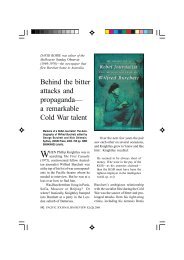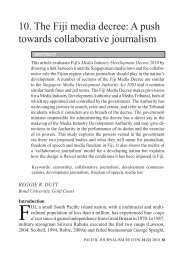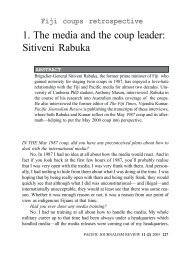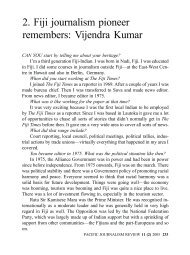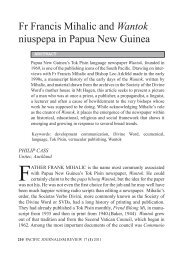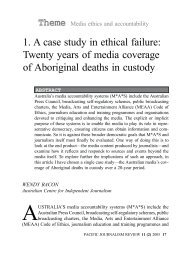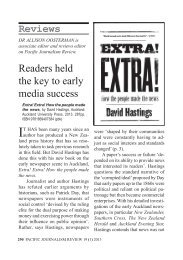Article Fiji's coup culture 1987-2006 - Pacific Journalism Review
Article Fiji's coup culture 1987-2006 - Pacific Journalism Review
Article Fiji's coup culture 1987-2006 - Pacific Journalism Review
Create successful ePaper yourself
Turn your PDF publications into a flip-book with our unique Google optimized e-Paper software.
REBUILDING PUBLIC TRUST<br />
who thought if Rabuka did it in <strong>1987</strong> and gained handsomely through his<br />
treasonous act, then why should they not try to achieve a similar result. Naidu<br />
(2007) of the University of the South <strong>Pacific</strong> (USP) agrees that what Speight<br />
did was imitate Rabuka but failed because of the lack of support from the<br />
military and the chiefs (p. 33). Robie (2000) agreed that while both Rabuka<br />
and Speight had conducted both <strong>coup</strong>s for ‘indigenous Fijian supremacy’,<br />
Speight was out to finish the unfinished business of ‘Fijianisation’ of Fiji that<br />
Rabuka had failed to achieve (p. 2). Had Rabuka allowed history to take its<br />
course without military intervention, perhaps Bainimarama might not have<br />
been placed in a position as the new commander to act as he did after seeing<br />
the poor governance, corruption and racism under the guise of a democracy<br />
which the military was seen to be protecting, enhancing and promoting.<br />
Bainimarama may not have had to use the military against the Fijians, which<br />
was the reason for Rabuka to carry out his first <strong>coup</strong> in <strong>1987</strong>. It is now seen<br />
as an exercise in futility. The November 2000 mutiny, which many suspect<br />
was instigated by Rabuka along with the convicted Naitasiri chief Ratu Inoke<br />
Takiveikata and other chiefs, ended with eight soldiers and rebels being killed<br />
(Bhim, 2000, p. 128): ‘Altogether eight soldiers, two policeman and two rebels<br />
were killed in the <strong>coup</strong> and the mutiny of 2000’ (Naidu, p. 31). This led to so<br />
much division, bad blood and heartbreak in the army, which previously had<br />
been a sacred institution for the Fijian community.<br />
The current demise of the Great Council of Chiefs, curbing of the Methodist<br />
Church and the restructure and reform of other Fijian institutions is<br />
because of that early action by Rabuka in <strong>1987</strong>. If the Fijian military is today<br />
being used against the Fijians to crush their racism and ethno-nationalism, it<br />
is also because of his action.<br />
While history has demonstrated that he was wrong in <strong>1987</strong>, it also reveals<br />
after all, he had not been such a bad person. He had admitted, through his<br />
subsequent actions, that his ethno-nationalism of <strong>1987</strong> was wrong. He redeemed<br />
his <strong>coup</strong>s by siding with Jai Ram Reddy and the National Federation<br />
Party (NFP) in delivering Fiji the 1997 multiracial constitution. In his quest to<br />
promote and revive multiracialism, he sacrificed his political career by siding<br />
with an Indo-Fijian party (NFP). He was dumped and his chief-sponsored party,<br />
the SVT, lost heavily in the 1999 elections. The Fiji Labour Party (FLP) and<br />
its coalition partners were the beneficiaries and, consequently, they enjoyed a<br />
landslide victory. It is said that both the Fijians and the Indo-Fijians are now<br />
172 PACIFIC JOURNALISM REVIEW 18 (2) 2012



